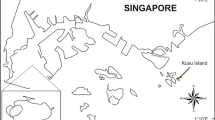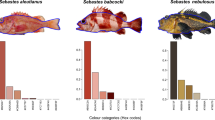Abstract
The rapid life cycles of freshwater algae are hypothesized to suppress selection for chemical defenses against herbivores, but this notion remains untested. Investigations of chemical defenses are rare for freshwater macrophytes and absent for freshwater red algae. We used crayfish to assess the palatability of five freshwater red algae relative to a palatable green alga and a chemically defended aquatic moss. We then assessed the roles of structural, nutritional, and chemical traits in reducing palatability. Both native and non-native crayfish preferred the green alga Cladophora glomerata to four of the five red algae. Batrachospermum helminthosum, Kumanoa holtonii, and Tuomeya americana employed activated chemical defenses that suppressed feeding by 30–60 % following damage to algal tissues. Paralemanea annulata was defended by its cartilaginous structure, while Boldia erythrosiphon was palatable. Activated defenses are thought to reduce ecological costs by expressing potent defenses only when actually needed; thus, activation might be favored in freshwater red algae whose short-lived gametophytes must grow and reproduce rapidly over a brief growing season. The frequency of activated chemical defenses found here (three of five species) is 3–20× higher than for surveys of marine algae or aquatic vascular plants. If typical for freshwater red algae, this suggests that (1) their chemical defenses may go undetected if chemical activation is not considered and (2) herbivory has been an important selective force in the evolution of freshwater Rhodophyta. Investigations of defenses in freshwater rhodophytes contribute to among-system comparisons and provide insights into the generality of plant–herbivore interactions and their evolution.





Similar content being viewed by others
References
Adler FR, Karban R (1994) Defended fortresses or moving targets? Another model of inducible defenses inspired by military metaphors. Am Nat 144:813–832
Baldwin IT (1998) Jasmonate-induced responses are costly but benefit plants under attack in native populations. Proc Natl Acad Sci USA 95:8113–8118
Blunt JW, Copp BR, Hu WP, Munro MHG, Northcote PT, Prinsep MR (2009) Marine natural products. Nat Prod Rep 26:170–244
Bolser RC, Hay ME (1998) A field test of inducible resistance to specialist and generalist herbivores using the water lily Nuphar luteum. Oecologia 116:143–153
Bowers MD, Stamp NE (1993) Effects of plant age, genotype and herbivory on Plantago performance and chemistry. Ecology 74:1778–1791
Bradford MM (1976) A rapid and sensitive method for the quantitation of microgram quantities of protein utilizing the principle of protein–dye binding. Anal Biochem 72:248–254
Camacho FA (2008) Macroalgal and cyanobacterial chemical defenses in freshwater communities. In: Amsler CD (ed) Algal chemical ecology. Springer, Berlin, pp 105–119
Cargill AS, Cummins KW, Hanson BJ, Lowry RR (1985) The role of lipids as feeding stimulants for shredding aquatic insects. Freshw Biol 15:455–464
Cetrulo GL, Hay ME (2000) Activated chemical defenses in tropical versus temperate seaweeds. Mar Ecol Prog Ser 207:243–253
Conn EE (1980) Cyanogenic compounds. Annu Rev Plant Physiol 31:433–451
Conover WJ, Iman RL (1981) Rank transformations as a bridge between parametric and nonparametric statistics. Am Stat 35:124–129
Creed RP (1994) Direct and indirect effects of crayfish grazing in a stream community. Ecology 75:2091–2103
Cronin GD, Lodge DM, Hay ME, Miller M, Hill AM, Horvath T, Bolser RC, Lindquist N, Wahl M (2002) Crayfish feeding preferences for freshwater macrophytes: the influence of plant structure and chemistry. J Crust Biol 22:708–718
Cruz-Rivera E, Hay ME (2003) Prey nutritional quality interacts with chemical defenses to affect consumer feeding and fitness. Ecol Monogr 73:483–506
Cummins KW, Klug MJ (1979) Feeding ecology of stream invertebrates. Annu Rev Ecol Syst 10:147–172
Cyr H, Pace ML (1993) Magnitude and patterns of herbivory in aquatic and terrestrial ecosystems. Nature 361:148–150
Dodds WK (1991) Factors associated with dominance of the filamentous green alga Cladophora glomerata. Water Res 25:1325–1332
Duffy JE, Hay ME (2001) Ecology and evolution of marine consumer–prey interactions. In: Bertness M, Gaines SD, Hay ME (eds) Marine community ecology. Sinauer, Sunderland, pp 131–157
Feminella JW, Hawkins CP (1995) Interactions between stream herbivores and periphyton: a quantitative analysis of past experiments. J N Am Benthol Soc 14:465–509
Gherardi F (2006) Crayfish invading Europe: the case study of Procambarus clarkii. Mar Freshw Behav Physiol 39:175–191
Gross EM (2003) Allelopathy of aquatic autotrophs. Critical Rev Plant Sci 22:313–339
Hambrook JA, Sheath RG (1987) Grazing of freshwater rhodophyta. J Phycol 23:656–662
Hay ME (1996) Marine chemical ecology: what’s known and what’s next? J Exp Mar Biol Ecol 200:103–134
Hay ME (2009) Marine chemical ecology: chemical signals and cues structure marine populations, communities, and ecosystems. Annu Rev Mar Sci 1:193–212
Hay ME, Kappel EQ, Fennical W (1994) Synergisms in plant defenses against herbivores: interactions of chemistry, calcification, and plant-quality. Ecology 75:1714–1726
Hay ME, Stachowicz JJ, Cruz-Rivera E, Bullard S, Deal MS, Lindquist N (1998) Bioassays with marine and freshwater organisms. In: Haynes KF, Millar JG (eds) Methods in chemical ecology. Chapman and Hall, New York, pp 39–141
Hill RW, Boston HL, Steinman AD (1992) Grazers and nutrients simultaneously limit lotic primary productivity. Can J Fish Aquat Sci 49:504–512
Hillebrand H (2008) Grazing regulates the spatial variability of periphyton biomass. Ecology 89:165–173
Hillebrand H (2009) Meta-analysis of grazer control of periphyton biomass across aquatic ecosystems. J Phycol 45:798–806
Hobbs HH (1989) An illustrated checklist of the American crayfishes (Decapoda, Astacidae, Cambaridae, Parastacidae). Smith Contri Zool 480:1–236
Hobbs HH (1993) Trophic relationships of North American freshwater crayfishes and shrimps. Milwaukee Public Museum Contributions Biol Geol 85:1–110
Holomuzki JR, Lowe RL, Ress JA (2006) Comparing herbivory effects of stream macroinvertebrates on microalgal patch structure and recovery. N Z J Mar Freshw Res 40:357–367
Holomuzki JR, Feminella JW, Power ME (2010) Biotic interactions in freshwater benthic habitats. J N Am Benthol Soc 29:220–224
Ianora A, Miralto A, Poulet SA, Carotenuto Y, Buttino I, Romano G, Casotti R, Pohnert G, Wichard T, Colucci-D’Amato L, Terrazzano G, Smetacek V (2004) Aldehyde suppression of copepod recruitment in blooms of a ubiquitous planktonic diatom. Nature 429:403–407
Jeffries MJ, Lawton JH (1984) Enemy free space and the structure of ecological communities. Biol J Linn Soc 23:269–286
Karban R, Baldwin IT (1997) Induced responses to herbivory. University of Chicago Press, Chicago
Karban R, Agrawal AA, Thaler JS, Adler LS (1999) Induced plant responses and information content about risk of herbivory. Trends Ecol Evol 14:443–447
Lamberti GA, Resh VH (1983) Stream periphyton and insect herbivores: an experimental study of grazing by a caddisfly population. Ecology 64:1124–1135
Lankau RA (2007) Specialist and generalist herbivores exert opposing selection on a chemical defense. New Phytol 175:176–184
Lau DCP, Leung KMY, Dudgeon D (2009) Are autochthonous foods more important than allochthonous resources to benthic consumers in tropical headwater streams? J N Am Benthol Soc 28:426–439
Lodge DM, Kershner MW, Aloi JE, Covich AP (1994) Effects of an omnivorous crayfish (Orconectes rusticus) on a freshwater littoral food web. Ecology 75:1265–1281
Lodge DM, Cronin GD, Van Donk E, Froelich AJ (1998) Impact of herbivory on plant standing crop: comparisons among biomes, between vascular and nonvascular plants, and among freshwater herbivore taxa. In: Jeppeson E, Sondergaard M, Christoffersen K (eds) The structuring role of submerged macrophytes in lakes. Springer, New York, pp 149–174
Lubchenco J, Cubit JD (1980) Heteromorphic life histories of certain marine algae as adaptations to variations in herbivory. Ecology 61:676–687
McClintock JB, Baker BJ (2001) Marine chemical ecology. CRC, Boca Raton
McKey DB (1979) The distribution of secondary compounds within plants. In: Rosenthal GA, Janzen DH (eds) Herbivores: their interactions with secondary plant metabolites. Academic Press, New York, pp 55–133
McNeely C, Finlay JC, Power ME (2007) Grazer traits, competition, and carbon sources to a headwater-stream food web. Ecology 88:391–401
Morrison WE, Hay ME (2010) Induced chemical defenses in a freshwater macrophyte suppress herbivore fitness and the growth of associated microbes. Oecologia 165:427–436
Mulholland PJ, Tank JL, Sanzone DM, Wollheim WM, Peterson BJ, Webster JR, Meyer JL (2000) Food resources of stream macroinvertebrates determined by natural-abundance stable C and N isotopes and a 15N tracer addition. J N Am Benthol Soc 19:145–157
Müller C (1978) On the productivity and chemical composition of some benthic algae in hard-water systems. Int Verh Thero Angew Limnol 20:1457–1462
Newman RM, Hanscom Z, Kerfoot WC (1992) The watercress glucosinolate-myrosinase system: a feeding deterrent to caddisflies, snails and amphipods. Oecologia 92:1–7
Parker JD, Burkepile DE, Collins DO, Kubanek J, Hay ME (2007) Stream mosses as chemically defended refugia for freshwater macroinvertebrates. Oikos 116:302–312
Pato LS, Martínez B, Rico JM (2011) Environmental control of the annual erect phase of Nemalion helminthoides (Rhodophyta) in the field. Sci Mar 75:263–271
Paul VJ, Van Alstyne KL (1992) Activation of chemical defenses in the tropical green algae Halimeda spp. J Exp Mar Biol Ecol 160:191–203
Power ME, Matthews WJ, Stewart AJ (1985) Grazing minnows, piscivorous bass, and stream algae: dynamics of a strong interaction. Ecology 66:1448–1456
Power ME, Parker MS, Dietrich WE (2008) Seasonal reassembly of a river food web: floods, droughts, and impacts of fish. Ecol Monogr 78:263–282
Prusak AC, O’Neal J, Kubanek J (2005) Prevalence of chemical defenses among freshwater plants. J Chem Ecol 31:1145–1160
Rhoades D (1979) Evolution of plant chemical defenses against herbivory. In: Rosenthal GA, Janzen DH (eds) Herbivores: their interactions with secondary plant metabolites. Academic Press, New York, pp 3–54
Roa R (1992) Design and analysis of multiple-choice feeding-preference experiments. Oecologia 89:509–515
Sheath RG (2003) Red algae. In: Wehr J, Sheath RG (eds) Freshwater algae of North America: ecology and classification. Academic, San Diego, pp 197–224
Sheath RG, Cole KM (1992) Biogeography of stream macroalgae in North America. J Phycol 28:448–460
Sheath RG, Hambrook JA (1990) Freshwater ecology. In: Cole KM, Sheath RG (eds) Biology of the red algae. Cambridge University Press, New York, pp 423–453
Sheath RG, Hellebust JA, Sawa T (1979) Floridean starch metabolism of Porphyridium purpureum (Rhodophyta). Phycologia 18:149–163
Sponseller RA, Grimm NB, Boulton AJ, Sabo JL (2010) Responses of macroinvertebrate communities to long-term flow variability in a Sonoran Desert stream. Global Change Biol 16:2891–2900
Stachowicz JJ, Hay ME (1996) Facultative mutualism between an herbivorous crab and a coralline alga: advantages of eating noxious seaweeds. Oecologia 105:377–387
Steinman AD (1996) Effects of grazers on freshwater benthic algae. In: Stevenson RJ, Bothwell ML, Lowe RL (eds) Algal ecology: freshwater benthic ecosystems. Academic, San Diego, pp 341–373
Steinman AD, Mulholland PJ, Kirschtel DB (1991) Interactive effects of nutrient reduction and herbivory on biomass, taxonomic structure, and P uptake in lotic periphyton communities. Can J Fish Aquat Sci 48:1951–1959
Steinman AD, Mulholland PJ, Hill WR (1992) Functional responses associated with growth form in stream algae. J N Am Benthol Soc 11:229–243
Stewart AJ (1987) Responses of stream algae to grazing minnows and nutrients: a field test for interactions. Oecologia 72:1–7
Stock MS, Richardson TD, Ward AK (1987) Distribution and primary productivity of the epizoic macroalga Boldia erythrosiphon (Rhodophyta) in a small Alabama stream. J N Am Benthol Soc 6:168–174
Stout EP, Kubanek J (2010) Marine macroalgal natural products. In: Mander L, Lui HW (eds) Comprehensive natural products II: chemistry and biology. Elsevier, Oxford, pp 41–65
Torres-Ruiz M, Wehr JD, Perrone AA (2007) Trophic relations in a stream food web: importance of fatty acids for macroinvertebrate consumers. J N Am Benthol Soc 26:509–522
Van Alstyne KL, Houser LT (2003) Dimethylsulfide release during macroinvertebrate grazing and its role as an activated chemical defense. Mar Ecol Prog Ser 250:175–181
Vergés A, Paul NA, Steinberg PD (2008) Sex and life-history stage alter herbivore responses to a chemically defended red alga. Ecology 89:1334–1343
Zar JH (2010) Biostatistical analysis, 5th edn. Prentice Hall, Upper Saddle River, pp 163–171
Acknowledgments
Funding was provided by the U.S. National Science Foundation (Integrative Graduate Education and Research Traineeship Program; DGE 0114400) and the Teasley endowment to Georgia Tech. C. Dell, D. Kemp, M. Heckman, M. Teasdale, and S. Engle aided in laboratory and field efforts. M. Vis and R. Holton provided information on red algal collection sites and helped with algal identification.
Author information
Authors and Affiliations
Corresponding author
Additional information
Communicated by Elena Litchman.
Rights and permissions
About this article
Cite this article
Goodman, K.M., Hay, M.E. Activated chemical defenses suppress herbivory on freshwater red algae. Oecologia 171, 921–933 (2013). https://doi.org/10.1007/s00442-012-2455-0
Received:
Accepted:
Published:
Issue Date:
DOI: https://doi.org/10.1007/s00442-012-2455-0




